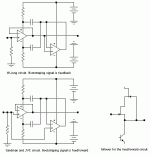The Analog device Application note AN-232 describes a method of bootstrapping the substrate of fet input Op Amps. The reason claimed is that a reduction in THD can result from using this method with mismatched input impedances on the Op amp’s inputs. The Bootstrap method apparently keeps the common mode voltage constant in the Fet input and thus reducing the nonlinear capacitance change with the signal. the note http://www.analog.com/UploadedFiles/Application_Notes/742022599AN232.pdf
I would like to get more opines on this.
I would like to get more opines on this.
Please, can you read this JVC paper
Feedforward Floating Power Supply (High Response Speed Equalizer Circuit)
Vol. 30, Number 5 pp. 324 (1982)
Author: Eiichi Funasaka
Author: Hikaru Kondou
Abstract: A method for drastically reducing nonlinear distortion and transient intermodulation distortion in noninverting unity-gain amplifiers is described. The method uses a floating power supply with feedforward and boot-strap techniques.
There are some measurement
The original idea was published in Wireless World. I will find it later.
Feedforward Floating Power Supply (High Response Speed Equalizer Circuit)
Vol. 30, Number 5 pp. 324 (1982)
Author: Eiichi Funasaka
Author: Hikaru Kondou
Abstract: A method for drastically reducing nonlinear distortion and transient intermodulation distortion in noninverting unity-gain amplifiers is described. The method uses a floating power supply with feedforward and boot-strap techniques.
There are some measurement
The original idea was published in Wireless World. I will find it later.
OK, the bootstrapping of the op amp supply rails was proposed by Sandman in Wireless World, vol. 80, pp.367-371 (1974 Oct) "Reducing amplifier distortion" but without explanation, as I remember. It is nice method for decreasing distortion in slow op amp based follower, may I repeat myself, only follower. I had used it in a past ... the follower then a noninverting amp (_gainclone_) 
Yes this technique seems to work quite well. If you look at the distortion measurements on almost any op-amp data sheet it in in inverting configuration. However, at the input to your pre-amp, amp, an inverting input is usually not possible due to the low input impedance.
I use a circuit similar to the one in the ADI app-note for general purpose applications. It sounds quite nice. There is another thread on non-inverting op-amp distortion. I posted a schematic over there.
Alvaius
I use a circuit similar to the one in the ADI app-note for general purpose applications. It sounds quite nice. There is another thread on non-inverting op-amp distortion. I posted a schematic over there.
Alvaius
I post both ideas. In W.Jung circuit the output slew rate is equal to the slew rate of first follower and cannot be improved. In JVC circuit it can be 10-100 times higher as the frequency compensation capacitors are also bootstrapped. The simple discrete BJT follower can be used for bootstrapping. If the input capacitance linearity is the issue, the more complex follower can be used (actually it has feedback bootstrapping).
Mr. Pass, it is nothing to do with substrate pin, it works like the second (opposite) gate and should be connected to source. Both source and drain should be bootstrapped.
Mr. Pass, it is nothing to do with substrate pin, it works like the second (opposite) gate and should be connected to source. Both source and drain should be bootstrapped.
Sandman articles
Hi all
I am looking for a couple of articles from Mr Sandman
(mentioned here) on feedfoward and and Sandman class-S amps.
They were published in Wireless world magazine in
the 70s and 80s. Here is the information I have:
1. Sandman, Wireless World, vol. 80, pp.367-371 (1974 Oct) "Reducing amplifier distortion"
2. A.M. Sandman, ‘CLASS-S: A Novel Approach To Amplifier Distortion’, Electronic And Wireless World, pp. 38-39, Sept. 1982.
If someone has this, can you email a scanned copy, or snailmail?
I checked my local library, and they don't have WW
TIA
Yv
(tinearsnospam@operamail.com) - remove 'nospam'
Hi all
I am looking for a couple of articles from Mr Sandman
(mentioned here) on feedfoward and and Sandman class-S amps.
They were published in Wireless world magazine in
the 70s and 80s. Here is the information I have:
1. Sandman, Wireless World, vol. 80, pp.367-371 (1974 Oct) "Reducing amplifier distortion"
2. A.M. Sandman, ‘CLASS-S: A Novel Approach To Amplifier Distortion’, Electronic And Wireless World, pp. 38-39, Sept. 1982.
If someone has this, can you email a scanned copy, or snailmail?
I checked my local library, and they don't have WW
TIA
Yv
(tinearsnospam@operamail.com) - remove 'nospam'
- Status
- This old topic is closed. If you want to reopen this topic, contact a moderator using the "Report Post" button.
- Home
- Amplifiers
- Solid State
- Bootstraping Op Amp substrate for lower Distortion
